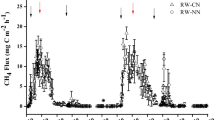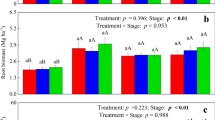Abstract
CH4 emission and its relevant processes involved (i.e. CH4 production, rhizospheric CH4 oxidation and plant-mediated CH4 transport) were studied simultaneously to comprehensively understand how rice cultivars (Yanxuan, 72031, and 9516) at growth stages (early and late tillering, panicle initiation, ripening, and harvest stage) affect CH4 emission in a paddy soil. Over the entire rice-growing season, Yanxuan had the highest CH4 emission flux with 5.98 μg CH4 m−2 h−1 followed by 72031 (4.48 μg CH4 m−2 h−1) and 9516 (3.41 μg CH4 m−2 h−1). The highest CH4 production rate of paddy soils planted to Yanxuan was observed with 18.0 μg CH4 kg{ (d.w.soil)} h−1 followed by the soil planted to 9516 (17.5 μg CH4 kg{ (d.w.soil)} h−1). For each cultivar, both rhizospheric CH4 oxidation ability and plant-mediated CH4 transport efficiency varied widely with a range of 9.81–76.8% and 15.5–80.5% over the duration of crop growth, respectively. Multiple regression analyses showed that CH4 emission flux was positively related with CH4 production rate and rice plant-mediated CH4 transport efficiency, but negatively with rhizospheric CH4 oxidation (R 2=0.425 for Yanxuan, P<0.01; R 2=0.426 for 72031, P<0.01; R 2=0.564 for 9516, P<0.01). The contribution of rice plants to CH4 production seems to be more important than to rhizospheric CH4 oxidation and plant-mediated transport in impact of rice plants on CH4 emission.
Similar content being viewed by others
References
Aulakh MS, Bodenbender J, Wassmann R & Rennenberg H (2000) Methane transport capacity of rice plants. II. Variations among different rice cultivars and relationship with morphological characteristics. Nutr Cycl Agroecosyst 58: 367–375
Banker BC, Kludze HK, Alford DP, DeLaune RD & Lindau CW (1995) Methane sources and sinks in paddy rice soils: Relationship to emissions. Agr Ecosyst Environ 53: 243–251
Cai ZC (1997) A category for estimate of CH4 emission from rice paddy fields in China. Nutr Cycl Agroecosyst 49: 171–179
Dannenberg S & Conrad R (1999) Effect of rice plants on methane production and rhizospheric metabolism in paddy soil. Biogeochemistry 45: 53–71
Denier Van Der Gon HAC & Neue HU (1996) Oxidation of methane in the rhizosphere of rice plants. Biol Fertil Soils 22: 359–366
Dlugokencky EJ, Masaire KA, Lang PM & Tans PP (1998) Continuing decline in the growth rate of the atmospheric methane burden. Nature 393: 447–450
Holzapfel-Pschorn A, Conrad R & Seiler W (1986) Effects of vegetation on the emission of methane from submerged paddy soil. Plant Soil 92: 223–233
Jia ZJ, Cai ZC, Xu H & Li XP (2001) Effect of rice plants on CH4 production, transport, oxidation and emission in rice paddy soil. Plant Soil 230: 211–221
Kludze HK Delaune RD & Patrick WH Jr (1993) Aerenchyma formation and methane and oxygen exchange in rice. Soil Sci Soc Am J 57: 386–391
Lin m & You C (1989) Root exudates of rice (Oryzs sativa L) and their interaction with Alcaligenes faecalis (in Chinese). Sci Agric Sin 22: 6–12
Lindau CW, Bollich PK, Delaune RD, Patrick WH Jr & Law VJ (1991) Effect of urea fertilizer and environmental factors on CH4 emissions from a Louisiana USA, rice field. Plant Soil 136: 195–203
Lu Y, Wassmann R, Neue HU, Huang C & Bueno CS (2000) Methanogenic responses to exogenous substrates in anaerobic rice soils. Soil Biol Biochem 32: 1683–1690
Matthews RB, Wassmann R, Knox JW & Buendia LV (2000) Using a crop/soil simulation model and GIS techniques to asses methane emissions from rice fields in Asia. IV. Upscaling to national levels. Nutr Cycl Agroecosyst 58: 201–217
Mosier AR (1998) Soil processes and global change. Biol Fertil Soils 27: 221–229
Neue HU, Wassmann R, Lantin RS, Alberto MCR, Aduna JB, Javellana AM, & Penkett S (1996) Factors affecting methane emission from rice field. Atmos Environ 30: 1751–1754
Sass RL, Fisher FM, Harcombe PA & Turner FT (1990) Methane production and emission in a Texas rice field. Global Biogeochem Cycles 4: 47–68
Satpathy SN, Mishra S, Adhya TK, Ramakrishnan B, Rao VR & Sethnathan N (1998) Cultivar variation in methane efflux from tropical rice. Plant Soil 202: 223–229
Schipper LA & Reddy KR (1996) Determination of methane oxidation in the rhizosphere of Sagittaria lancifolia using methyl fluoride. Soil Sci Soc Am J 60: 611–616
Schutz H, Holzapfel-Pschorn A, Conrad R, Rennenberg H & Seiler W (1989) A 3-year continuous record on the influence of daytime, season, and fertilizer treatment on methane emission rates from an Italian rice paddy. J Geophys Res 94: 16405–16416
Wang B & Adachi K (2000) Differences among rice cultivars in root exudation, methane oxidation, and populations of methanogenic and methantrophic bacteria in relation to methane emission. Nutr Cycl Agroecosyst 58: 349–356
Wang B, Neue HU & Samonte HP (1997) Effect of rice plant on seasonal methane emission patterns. Acta Agron Sin 23: 271–279
Wassmann R & Aulakh MS (2000) The role of rice plants in regulating mechanisms of methane missions. Biol Fertil Soils 31: 20–29
Wassmann R, Neue HU, Bueno C, Lantin RS, Alberto MCR, Buendia LV, Bronson K, Papen H & Rennenberg H (1998) Methane production capacities of different rice soils derived from inherent and exogenous substrates. Plant Soil 203: 227–237
Watanabe A, Kajiwara M, Tashiro T & Kimura M (1995) Influence of rice cultivar on methane emission from paddy fields. Plant Soil 17: 51–56
Watanabe I, Takada G, Hashimoto T & Inubushi K (1997) Methane-oxidizing activities and methanotrophic populations associated with wetland rice siols. Biol Fertil Soils 24: 261–265
Xu H, Cai ZC, Jia ZJ & Tsuruta H (2000a) Effect of land management in winter crop season on CH4 emission during the following flooded and rice-growing period. Nutr Cycling Agroecosyst 58: 327–332
Xu H, Cai ZC, Li XP & Tsuruta H (2000b) Effect of antecedent soil water regime and rice straw application time on CH4 emission from rice cultivation. Aust J Soil Res 38: 1–12
Author information
Authors and Affiliations
Corresponding author
Rights and permissions
About this article
Cite this article
Jia, Z.J., Cai, Z.C., Xu, H. et al. Effects of rice cultivars on methane fluxes in a paddy soil. Nutrient Cycling in Agroecosystems 64, 87–94 (2002). https://doi.org/10.1023/A:1021102915805
Issue Date:
DOI: https://doi.org/10.1023/A:1021102915805




